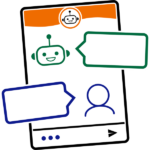Description
Scratch Coding Lessons
Spark an interest in computer science with fun Scratch coding lessons. In TechnoArcade, students dive into the world of game development. They use Scratch activities to build a series of arcade games – Jumble Tumble, Let’s Jam, Mystery Island, and Lost Treasure. Upon completion, gaming fans share the fun in an online arcade.
Programming for Beginners in Grades 3-6
Students ages 8-11 creates games with block-based coding. Lessons gradually introduce programming concepts through fun, simple activities. The six sessions focus on specific skills, starting with simple tasks and progressing to more complex challenges. In the first games they explore scripts, loops, and motion blocks. The second game introduces the sound library and uses the keyboard to control events. The following game applies the looks blocks, repeat, and sequencing actions. Finally, students learn to use conditionals, operators, and variables to control game play. Altogether, the lessons lay a solid foundation in coding skills.
Foster Computational Thinking
Step-by-step instructions guide students in sequencing coding blocks to control game play. Activities promote logical thinking as students create scripts, trigger events, loop actions, control timing, debug errors, and more.
Enhance Digital Citizenship with Scratch Coding Lessons
The free program Scratch gives students access to an online community. As members, they learn about privacy and security. They also experience how sharing projects is an excellent way to build coding skills and contribute to a digital collection of activities.
Ready-to-Go Lessons
TechnoArcade includes a digital Teacher Guide featuring easy to follow instructions. Assessment tools include a marking sheet, quizzes, and a skill checklist. Let the coding begin!
The TechnoArcade course has 18 assignments divided into six sessions.
Session 1: Arcade Hero
Students become arcade heroes. They prepare to build an online arcade for kids. To start, they register for a free Scratch account to gain access to the online coding platform. Afterwards, they explore the program to learn about common tools and terminology. By connecting blocks to make a script they discover how to control a sprite.
Session 2: Jumble Tumble
Students build Jumble Tumble. In this game a press of a key creates a mish mash of characters dashing and rolling across the screen. This chaotic scene uses Motion blocks to control movement. By sequencing the coding blocks, students discover how to direct and loop action. For an extra challenge, they can use if-then logic to create a silly outcome when two sprites crash.
Session 3: Let's Jam
Students put together a band. They design a game that transforms the keyboard into a musical instrument. Players will enjoy leading a jam session as they tap away at the keys. Students wanting a personal touch can add a variable that allows the player to name the new music group.
Session 4: Mystery Island
Students create Mystery Island. In this game, players explore an imaginary land. By tapping objects, they discover strange creatures. To build the code, Looks blocks are combined to change the appearance of sprites. Coders wanting to create an extra surprise can use random operators.
Session 5: Lost Treasure Part One
Students begin to create the game Lost Treasure. In it, players collect items to score points. The player moves the mouse to pick up lost items and carries them to a specific spot. To start, students plan the theme of their game. Next, they insert a setting, hero, and treasure. With this complete, the game designers build code to control the movement of the hero. Sounds and Looks blocks combine to add excitement to the game play.
Session 6: Lost Treasure Part Two
Students finish designing the game Lost Treasure. They create a variable to keep score. Using the Wait Until coding block, they build a script that ends the game when all hidden items are found. An optional activity has students create a timer to have players race against the clock. Upon completion, a tester plays the game.
Optional Scratch Coding Lessons for Kids
- Wacky Word: Press keys to animate letters.
- Dash and Crash: Trigger sprites to do silly things when they bump into one another.
- Yikes! Run Away: Save the character from something scary.
- Hide and Seek: Code a game with hidden items.
- Surprise Me: Add random operators to make a game interesting.
- Create a Timer: Make game players race against the clock.
Scratch Coding Lessons for Elementary and Middle School
TechnoArcade activities introduce Scratch programming for beginners. With guided instructions, students learn how to combine Scratch coding blocks to create simple games. Extension activities challenge learners to personalize their arcade and extend their programming skills.
- Create arcade games using Scratch coding blocks
- Control events with sequences, events, loops, & conditionals
- Break problems into parts to simplify the design process
- Plan game features such as theme, setting, hero, & treasure
- Test and debug code
- Collaborate with peers throughout the game design process
- Reflect upon program development in a coding journal
- Consider how computing technologies have changed gaming
- Develop computational thinking skills
- Compare scripts to notice the change in output
TechnoArcade | Scratch Coding Lessons
DownloadBecome a game developer. Build Jumble Tumble, Let's Jam, Mystery Island, and more. Invite friends to an online arcade.


















Reviews
There are no reviews yet.